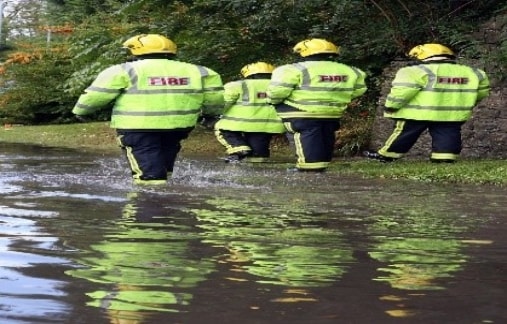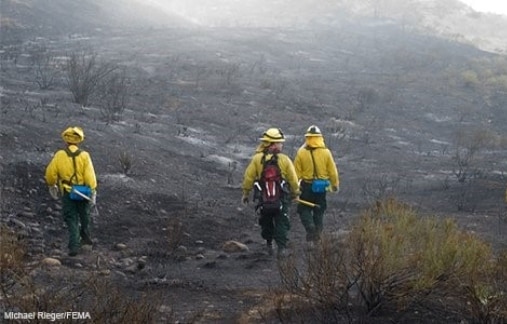Guidance for Post-exposure Medical Screening of Workers Leaving Hurricane Disaster Recovery Areas



Working in physically demanding, unclean, or unstable work environments, such as hurricane recovery areas, raises the question of whether work exposures will have adverse health consequences. The likelihood of such adverse health outcomes will depend on factors such as work load and work duration, type and severity of work exposures, and work organization, as well as the workers’ prior physical and mental health status, knowledge about and experience with disaster work, and precautions taken while working (e.g., work practices, personal protective equipment).
Because of potential health risks inherent in post-disaster work, screening programs should be undertaken to determine the extent, if any, to which individual workers have been adversely affected by their work and to identify as early as possible any affected workers needing preventive measures or medical care. This document is intended for occupational health professionals and other clinicians who are responsible for physical and mental health oversight of workers who have deployed or worked in hurricane disaster response (e.g., response and recovery workers). It provides guidance on an appropriate medical screening approach for these workers as they complete their response activities or return home from the affected areas. The document does not address issues related to the period prior to initiating response or recovery work, such as pre-deployment screening, medical clearance, or training; these are important occupational safety and health considerations that are addressed in a companion document. This document will be reassessed periodically and updated as appropriate.
In general, the level of screening appropriate for a given work activity depends on multiple factors. However, because the conditions encountered by response and recovery workers may involve complex, uncontrolled environments, possibly involving multiple or mixed chemical exposures, hazardous substances, microbial agents, temperature extremes, long work shifts, or stressful experiences, all such workers should receive some assessment as a precaution. This may range from completion of brief assessment forms to more comprehensive and focused evaluations. High priority worker groups include those most likely to have exposures to hazardous agents or conditions and those reporting outbreaks of similar adverse health outcomes. Public health criteria, such as frequency of adverse health effects; their severity, preventability, or communicability; public interest; and cost effectiveness, are often useful for setting screening priorities.
The primary purpose of worker screening programs is to protect worker health by early identification of work-related conditions in individual workers. Through screening, adverse effects in individuals can be recognized in a timely way to provide intervention for the individual, while identifying potential risks to others in the same population of workers or populations with similar exposures. The goal of screening is to identify those who need further medical attention, not necessarily to definitively diagnose or treat based only on information provided through the screening. Therefore, screening programs collect and analyze individual-specific data related to post-exposure physical and mental health status, which are used to:
- Detect possible adverse mental or physical health effects related to work or exposure
- Identify those who need further medical evaluation and treatment
- Monitor developing trends and patterns of illness or sequelae to injury or exposure among workers
When developing a post-exposure screening program, it is important to determine who should be screened and the reasons for screening them. For each group of workers, work-related risk factors or characteristics of commonly experienced occupational injuries and illnesses will determine the level or extent of screening appropriate to members of the group. These may include emotional as well as physical health factors. The following factors should be considered:
- Exposures or other risk factors encountered while deployed
- Type of work performed
- Dates of deployment
- Specific locations of work assignments
- Characteristics of work locations and relationship to known or suspected hazardous agents or conditions
- Specific job tasks and work load at work locations
- Specific high-risk exposures or conditions at work locations (e.g., contaminated floodwaters, moldy indoor environments, oil or other toxic spills)
- Exposure to traumatic events
- Protective measures used to prevent hazardous exposures (e.g., use of personal protective equipment)
- Dates started and finished work at locations listed above
- Shift schedules: hours per day, days per week, rotation schedules
- Reports of adverse health effects among particular groups of workers with similar job tasks, work location, exposure characteristics, etc.
Given the broad range of potential hazards and difficult working conditions encountered in hurricane response work, all workers returning from or completing hurricane response activities should receive some basic screening to capture information about their demographics, preexisting medical conditions, work experience and potential exposures while deployed, and any injuries or illness symptoms experienced while in the field or since leaving the disaster area. As described below, those meeting certain criteria should receive more extensive screening.
In the early phases of response efforts, it is often not possible to fully characterize the spectrum of hazardous agents and conditions that may have caused immediate or may cause future adverse health outcomes. As time elapses following hurricanes, environmental conditions, response activities, exposures, and possible health outcomes will continue to evolve, and information about some of these factors may remain incomplete.
It is not possible to specify here a single defined set of conditions for which workers should be screened. Decisions about screening needs and which health outcomes to monitor should be based on information about known or suspected risk factors (listed in the section “Determining a Need for Screening”), which is elicited through the basic screening recommended for all workers leaving the disaster area. Similarly, acute physical, cognitive, or emotional symptoms experienced during response work may be indicators of a potential future chronic condition, so the presence of symptoms during or after deployment may indicate a need for more extensive screening.
Different screening approaches will be appropriate for different groups. For example, rescue and recovery workers with prolonged and repeated exposures to contaminated floodwater, workers at an evacuation center, truck drivers delivering supplies, and workers handling logistics at a staging facility will each require different screening strategies.
Without specific information about chemical exposures, biological monitoring (i.e., measuring in body tissues or fluids [such as blood or urine] a chemical, one or more of its metabolites, or a biochemical marker of its effects) will not have great predictive or diagnostic value, nor would it be expected to be cost effective. Such specific exposure information is unlikely to be available for most locations and circumstances. Additionally, biological monitoring would be recommended only if its use as a screening tool for a specific exposure were well established and certain criteria were met, for example, exposure to the specific hazardous agent; ability to retrieve the agent or its metabolites from the body; existence of established reference values for interpreting test results; and relevance and usefulness of results (e.g., important for determining treatment and for predicting health outcome, severity, chronicity, or need for future screening or surveillance). Any other use of biological monitoring would be considered investigative (e.g., toxicology research), with objectives that are different from those of screening programs.
Finally, in addition to documenting predictable adverse health outcomes (on the basis of known exposures, activities, and work conditions), screening programs may identify unexpected health outcomes. Should such a potential emerging problem be identified, further investigation using an epidemiologic or “outbreak investigation” model may be necessary to characterize it and assess possible work-relatedness. If this investigation suggests that the unanticipated health outcome was related to response work, the screening program could then be modified to incorporate this new information to detect reappearance of the problem at an early stage.
Immediate data on post-exposure health status should be collected at the time of completion of response work or departure from the affected area, or as soon as possible afterward.
Depending on what is learned about exposures and on the results of the initial screening, more detailed medical evaluation may be indicated. Long-term data on health status may need to be collected on some individuals after a period away from exposure. Timing will depend on the nature of the exposure or health condition.
The following information should be collected on all individuals undergoing screening upon completion of or return from response or recovery activities:
Personal information
Identifying and Contact Information
- Name, address, appropriate telephone number(s), e-mail addresses (work, personal)
- Age, date of birth, birthplace, sex, social security number
- Contact information for someone who will know where the worker is 6 months after leaving response work
- Response organization:
- Employer vs. volunteer organization (indicate which)
- Name and address
- Contact person’s name and telephone number
Usual work
- Industry, occupation, job tasks, number of years
Special needs
- Primary language
Health status before response work
- Preexisting medical and mental health conditions
- Relevant lifestyle factors (e.g., smoking status)
- Other specific risk factors (depend on job, e.g., use of personal protective equipment, exposures)
- Immunization status: adult and special risk (e.g., health care worker)
Response-related information
Response work
- Type of work performed as response or recovery worker and circumstances under which that work was performed, with special attention to documentation of the geographic location of the work and when the work was performed. See the section titled “Determining a need for screening.”
For known hazardous exposures or conditions
- Type of exposure or conditions, work practices, and protective measures (e.g., personal protective equipment)
Injuries sustained or symptoms experience during response work
- Injuries: description of injury and circumstances; treatment received; whether injury resolved or still present
- Symptoms: type, new onset or exacerbation of preexisting condition, treatment, if any; symptom still present after return or new symptoms developed after return
- It may be appropriate to include specific screening for stress-related or emotional symptoms
Workers leaving disaster work who report repeated or prolonged exposures or who report injuries or symptoms should receive more comprehensive screening, which should address the specific exposures or adverse health effects encountered. Additional screening may include a more comprehensive medical history and review of symptoms, a physical examination, or, in some instances, laboratory testing, as indicated by clinical judgment and good occupational medical practice.
For reported exposures
If potentially significant exposures are reported, additional screening should be directed to detect potential adverse affects commonly associated with these exposures. Thus, for example, if repeated or prolonged exposures to dusty or moldy environments are reported, screening should address possible respiratory or allergic outcomes.
For reported symptoms
If illnesses or symptoms are reported, information should be obtained regarding corresponding organ systems (e.g., cardiac, respiratory, gastrointestinal, skin, mental health), symptoms, whether illnesses or symptoms represent new onset or exacerbation of preexisting condition, and treatment, if any.
For reported injuries
If injury is reported, information should be obtained regarding location and operation where injury occurred, nature of injury, part of body affected, severity (e.g., lost work time), and treatment. Minimum information about injury should include information sufficient to meet OSHA requirements for recordable injuries. Injuries caused by acts of violence should be included.
For the reasons listed in the previous section titled “Purpose of Screening,” screening programs may be set up by various organizations, including public health agencies from all levels of government, public sector response programs (including regulatory agencies and contractors), medical staff at private companies, or individual practitioners. To maintain confidentiality of workers’ medical information, medical or public health personnel typically administer screening programs. Other interested parties, such as public health organizations, academicians, media, labor unions, and attorneys, may want access to grouped screening results (with individual identifiers removed) for other reasons; policies for handling such requests should be developed in advance.
Administrative
- Decisions should be based on needs assessment before establishment of any screening program
- Programs should address clearly stated objectives
- Those staff members with access to data results should be clearly identified
- Policies, mechanisms, administration, and monitoring of privacy, confidentiality, and data security concerns should be stated clearly
- Adequate funds, personnel, materials, space, timeframe should be available
- Provisions should be made to ensure a system is in place for prompt and effective referral for more definitive evaluation and possible treatment of workers identified with emergent medical problems, whether physical or psychological
Staffing
- Program administrator
- Designated custodian of information collected
- Staff dedicated to collecting the information should be trained in the importance of accurate data collection, privacy, and confidentiality of sensitive and medical information
- Staff members available to analyze the data and interpret and report the results
Logistics
- Data collection locations should be convenient to workers (e.g., central location where workers report)
- Private space for maintenance of privacy
- Secure space for maintenance of confidential information
Other
- Screening instrument should be simple, concise, and standardized when available and appropriate.
- Screening system should be simple enough for administration by healthcare professionals
- Program should recognize potential implications regarding worker’s compensation and related issues
Summary
- Workers involved in hurricane response may encounter hazardous or stressful working environments and may be at risk for work-related adverse health consequences.
- All workers returning from or completing response and recovery activities should undergo as soon as feasible basic screening to document their activities and working conditions and identify any recognized exposures, illnesses, or injuries.
- Workers who report repeated or prolonged hazardous exposures, injuries, or symptoms or for whom specific risk factors are identified in the basic screening should receive more comprehensive screening, which should be directed at the risk factors, exposures, or adverse health effects encountered.
